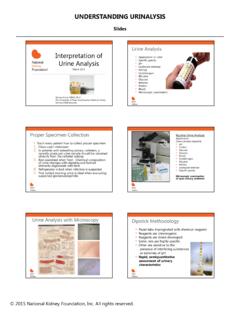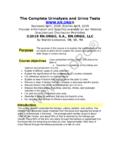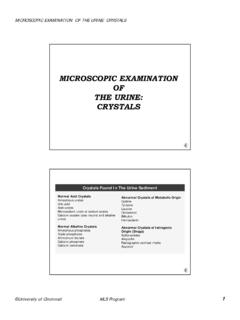Transcription of THE URINALYSIS REAGENT STRIPS
1 Copyright 2010 Alfred Ricks Jr., All rights reserved. This document may not be reproduced in any form or by any electronic or mechanical means, including information storage and retrieval systems without permission in writing from the author. This document is for use with The URINALYSIS REAGENT STRIPS video. THE URINALYSIS REAGENT STRIPS Alfred Ricks Jr., The URINALYSIS REAGENT STRIPS (Page 2) 2010 Alfred Ricks Jr., All rights reserved. For use with The URINALYSIS REAGENT STRIPS video. DISCLAIMER Information contained in this publication has been reviewed, but errors may remain. Neither the publisher nor the author assumes any liability for the use of this information in any treatments, for any injury from the use of this information, and any damages from the use of the information found in this publication.
2 Users of this information should verify the accuracy prior to use. The medications/products names and trademarks found in this publication are the property of the respective pharmaceutical company. This publication does not endorse any medication/product indication or use of any medication/product. Medications/products listed in this publication are only for examples. The information in this publication may contain errors. The URINALYSIS REAGENT STRIPS (Page 3) 2010 Alfred Ricks Jr., All rights reserved. For use with The URINALYSIS REAGENT STRIPS video. THE URINALYSIS Page REAGENT STRIPS 4 Renal Function Overview 7 Tests of Tubular Reabsorption and Tubular Secretion 10 Osmolarity / Osmolality and Specific Gravity 11 Urine Color 13 Urine Clarity or Appearance 16 Urine PH 17 Urine Specific Gravity 18 Urine Protein 19 Urine Glucose 20 Urine Ketones 21 Urine Blood 22 Urine Bilirubin 24 Urine Urobilinogen 26 Urine Nitrite 27 Urine Leukocyte Esterase 28 Urine Microscopic Exam 29 Appendix A (Blood in Urine) 31 Appendix B (Protein in Urine) 32 Appendix C (Summary / URINALYSIS REAGENT STRIPS ) 34 The URINALYSIS REAGENT STRIPS (Page 4) 2010 Alfred Ricks Jr.
3 , All rights reserved. For use with The URINALYSIS REAGENT STRIPS video. URINALYSIS REAGENT TEST STRIPS The REAGENT test STRIPS are important urine screening tests, but there are false negative and false positives as well as many other factors that affect the results. An understanding of the various factors affecting each test is needed to interpret the results and make the results clinically useful. REAGENT STRIPS are plastic STRIPS with pads containing chemicals. The urine reacts with the chemicals to produce a color in the pad and the color correlates with a specific value for each pad. Pads are on the plastic strip for testing glucose, bilirubin, ketones, specific gravity, blood, pH, protein, urobilinogen, nitrite, and leukocytes. Information and test results may vary depending on which brand of REAGENT strip used, so become familiar of the specifics of the brand that you use.
4 The package insert would be a good starting point. Multistix and Chemstrip are two common brands. PRECAUTIONS / PROCEDURES There are several general procedures and precautions for using REAGENT STRIPS and testing urine specimens. A midstream clean catch urine is usually satisfactory. A well mixed, uncentrifuged, room temperature urine specimen is used for testing. The urine should be tested within 2 hours (sooner if testing for bilirubin or urobilinogen) or multiple testing errors can result. Refrigeration at 20C (350F) to 80C (460F) is the most common way to preserve the urine for testing if there is a delay in testing. Culturing can be done up to 24 hours on refrigerated urine. Refrigeration increases the specific gravity and interferes with urine sediment examination and REAGENT test STRIPS . Allowing the urine to return to room temperature will allow proper REAGENT strip testing, better urine sediment examination, and a correct specific gravity.
5 Do not allow run off of urine from one pad to the next pad. Do not read the strip after 2 minutes as color changes are no longer considered accurate. Machines are preferred to read the strip pads, but if reading manually, you must read each pad at the specified time, in a well lighted area, using each brand s specific color chart. Store the REAGENT STRIPS in the original container with its desiccant. Keep the lid tight on the container. Take REAGENT strip out only when you are ready to use it. Check the expiration date or the REAGENT STRIPS . Do not touch the pads with your fingers. Improperly stored, improperly used, and expired REAGENT STRIPS will cause inaccurate results. Urine REAGENT STRIPS , also called dipsticks, are used to test the urine for various items. The URINALYSIS REAGENT STRIPS (Page 5) 2010 Alfred Ricks Jr.
6 , All rights reserved. For use with The URINALYSIS REAGENT STRIPS video. The URINALYSIS REAGENT STRIPS (Page 16) 2010 Alfred Ricks Jr., All rights reserved. For use with The URINALYSIS REAGENT STRIPS video. URINE CLARITY OR APPEARANCE Normal urine is usually clear, but clear urine does not always indicate normal urine. Causes Of Urine That Is Not Clear Refrigeration Urine left standing for hours Semen in urine Mucus in urine Squamous epitheal cells in urine Radiological contrast media Contamination (feces, vaginal creams, powders, etc.) RBCs WBCs Bacteria Yeast Nonsquamous epithelial cells Lipids Crystals Lymph fluid URINE PH There is no normal value for urine pH. The value is noted in relationship to the blood s pH, diet, infection, and renal function. The urine pH ranges from to The first morning urine usually has a pH of to With a blood pH of , the urine pH is usually about Urine pH should be acidic with metabolic or respiratory acidosis.
7 Urine pH should be alkaline with metabolic or respiratory alkalosis. If it is not, it indicates: a.) there is not metabolic or respiratory acidosis/alkalosis, or b.) a kidney disorder of secretion/reabsorption to regulate acid/base. ACID URINE (decreased pH) Diabetes mellitus Dehydration Starvation Respiratory or metabolic acidosis High protein diet Mandelamine Urinary tract infection (E. coli) ALKALINE URINE (elevated pH) Renal tubular acidosis Respiratory or metabolic alkalosis Old urine specimen Vegetarian diet Citrus fruits Obstructing renal stone Urinary tract infection with urea splitting organism converting urea to ammonia (proteus) REAGENT Strip Testing Errors Old urine specimens (increases the pH). Adjacent pad runoff can contaminate another pad and cause erroneous values. If protein (acidic) pad is adjacent to the pH pad, the runoff to the pH pad can cause the pH to be lower (acidic) than the actual value.
8 The URINALYSIS REAGENT STRIPS (Page 17) 2010 Alfred Ricks Jr., All rights reserved. For use with The URINALYSIS REAGENT STRIPS video. The URINALYSIS REAGENT STRIPS (Page 23) 2010 Alfred Ricks Jr., All rights reserved. For use with The URINALYSIS REAGENT STRIPS video. HEMATURIA CAUSES (also see Appendix A, page 31) Glomerular Involves glomerular disease and urine usually contains protein and RBC casts. Berger s disease is the most common cause. Renal (nonglomerular) Hematuria due to disorders of the kidney vascular, tubular and interstitial areas. Includes hematuria due to metabolic disorders. Urine usually also contains protein without RBC casts. Urologic Involves stones, infections, and tumors. Urine usually has little to no protein or RBC casts. REAGENT STRIPS Intact RBCs are lysed when they come into contact with the non hemolyzed pads and the released hemoglobin forms a speckled pattern on the pad.
9 The strip has a trace and a moderate pad for non hemolyzed (intact) RBCs. The strip has a trace, small, moderate, and large pad for hemolyzed (lysed) RBCs. REAGENT Strip Testing Errors False Positive High pH, strong oxidizing agents (hypochlorite bleach), myoglobinuria, exercise, dehydration, semen, menstrual blood contamination, bacterial infection (E. coli). False Negative ascorbic acid (pads have been modified to reduce this error). Proteins in urine. High specific gravity (crenated RBCs in concentrated urine may not lyse on pad). pH < Unmixed specimen (RBCs may settled on the bottom of specimen and missed). Formalin, captopril, high concentrations of nitrite. The URINALYSIS REAGENT STRIPS (Page 25) 2010 Alfred Ricks Jr., All rights reserved. For use with The URINALYSIS REAGENT STRIPS video.
10 URINE BILIRUBIN (CONT.) The diagram, on page 24, explains the following results: Urine Bilirubin Urine Urobilinogen Hemolytic disease Negative Increased Bile duct obstruction Increased Normal Liver damage Pos. or Neg. Increased Bilirubin is not usually found in urine. Unconjugated bilirubin is water insoluble, attached to albumin, and cannot be filtered by the glomerulus. Conjugated bilirubin is water soluble and can be filtered by the glomerulus. The level of conjugated bilirubin is usually not high enough to result in significant level to appear in the urine. Bilirubin in the urine should raise suspicion of liver disease or biliary obstruction. Urine Bilirubin Hepatitis, biliary obstruction (stone, cancer), cirrhosis, liver disease. REAGENT Strip Testing Errors False Positive phenazopyridine, pigments, indicans, metabolites of lodine.




